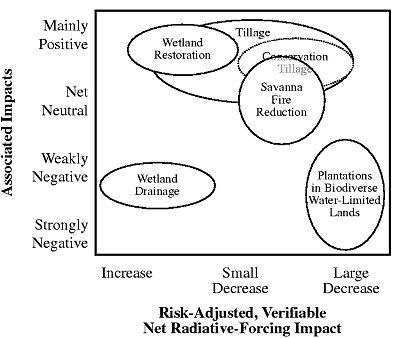|
4.7.2. Examples
Several examples are given in the following sections. These examples have been
selected for no special reason other than that they illustrate different criteria
coming into play, leading to different outcomes ( see Figure
4-14). The details underpinning the examples can be found in relevant
Fact Sheets at the end of this chapter.

|
|
Figure 4-14: Application of decision framework
described in Section 4.7.1. Cases are elaborated
in Section 4.7.2 and are chosen simply to demonstrate
different outcomes, not to promote or discourage any particular activity.
The most favorable activities would fall in the top right corner of
the graphic. Those in the left third would be hard to justify in purely
climate terms; those in the bottom quarter may be disqualified by unacceptably
high associated impacts.
|
4.7.2.1. Restoration of Wetlands
This example illustrates the tradeoffs between the carbon stock increase that
can be achieved by reflooding areas of drained wetlands and the reestablishment
of methane emissions that will result (see Fact Sheet 4.18).
The average annual carbon sequestration is less than 10 t C ha-1 yr-1, once
spatial variability has been taken into account (but note that where restoration
prevents an ongoing emission of carbon, the effective carbon storage rate relative
to no intervention may be higher). The carbon that is formed is relatively stable
because much of it is in the form of humus and is dependent only on the continuation
of the flooding regime. In the process, methane emissions are reestablished.
Given a 100-year GWP of 21 for methane relative to carbon dioxide (i.e., a GWP
of 5.7 relative to carbon) and an annual methane emission that can exceed 2
t CH4 ha-1 yr-1, the net effect can range from slightly reduced to a slightly
increased radiative forcing. The associated impacts-principally on biodiversity
and hydrology-are generally positive.
4.7.2.2. Drainage of Wetlands
Despite the fact that restoration of wetlands could lead in some cases to a
net increase in radiative forcing, drainage of wetlands will not necessarily
reduce global warming. The rate at which carbon is lost from wetlands following
drainage is much faster than the rate at which it accumulates when they are
flooded; in general, therefore, the increased radiative forcing caused by carbon
dioxide outweighs the reduced forcing resulting from lower methane emissions.
Where the drained wetlands are planted with trees, increased carbon inputs from
fine roots may slow or reverse carbon loss by respiration (Finér and Laine,
1998; Minkkinen and Laine, 1998). In addition, there are negative impacts on
biodiversity and water quality that must be balanced against non-environmental
benefits such as food production or disease prevention.
|